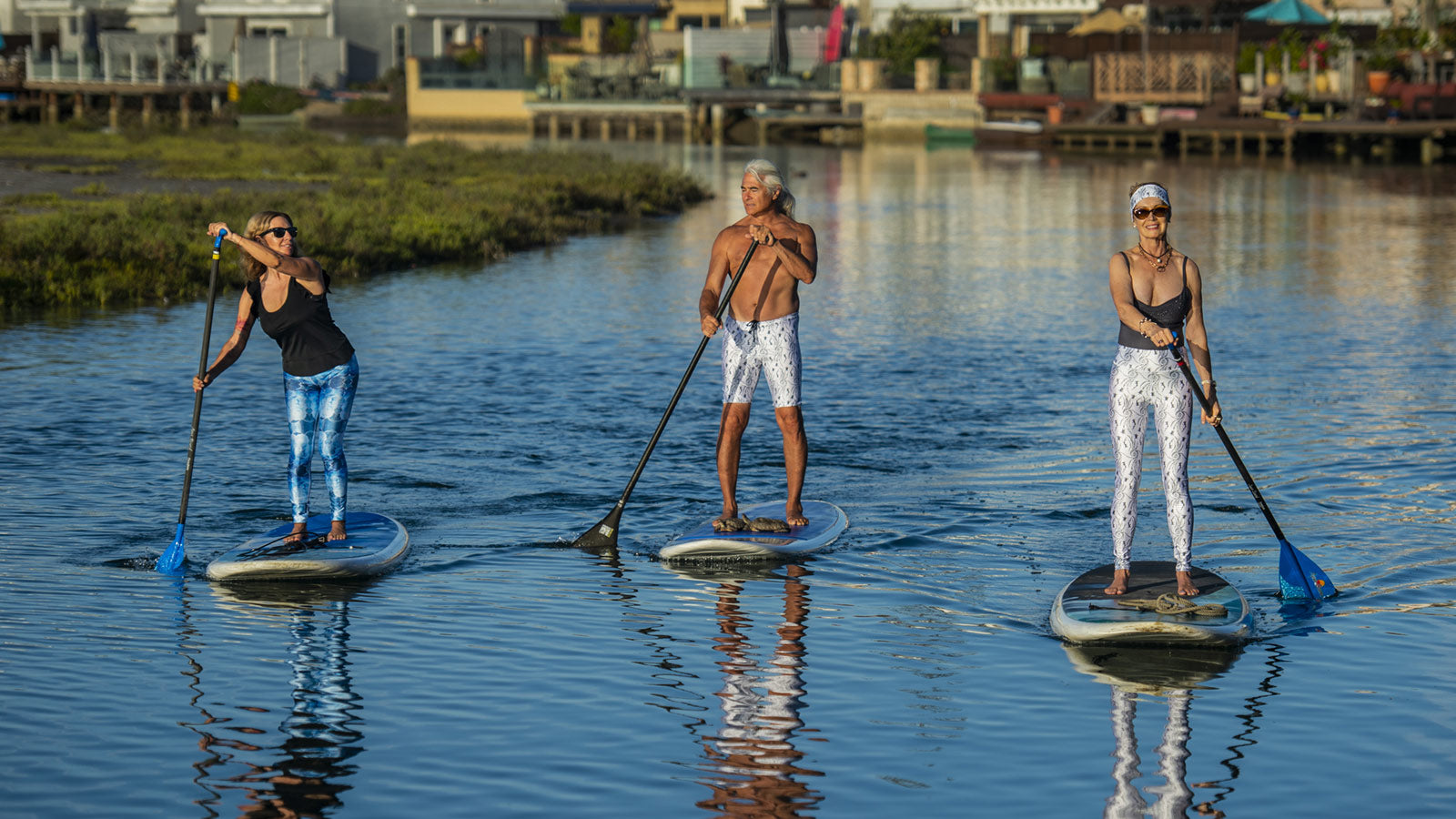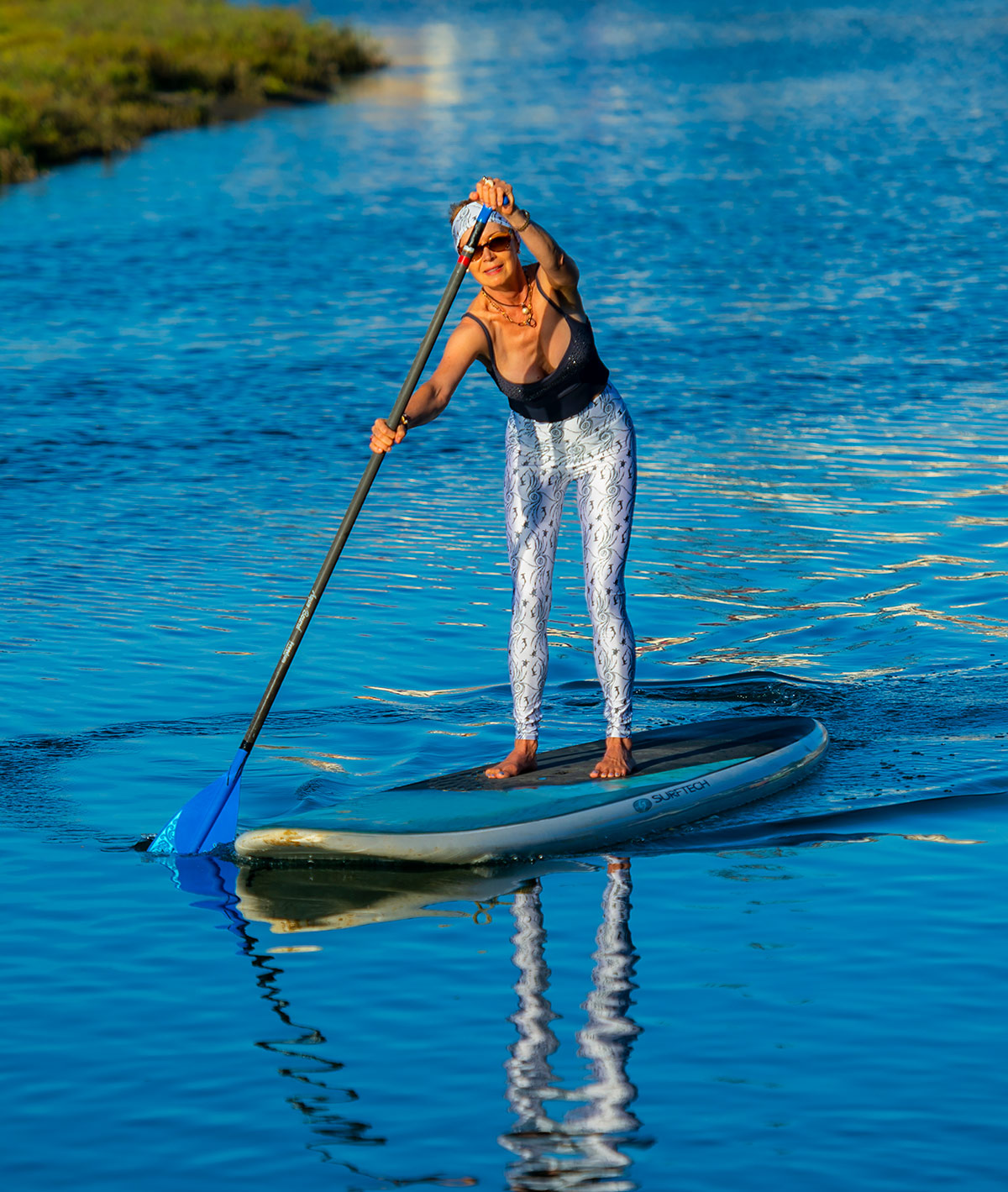Paddle Board Play Time with SlipIns
 SlipIns Sky Blue Sea Legs - Azul, Jammer Shorts - Ocean Currents, SlipIns White Sea Legs - Ocean Currents
SlipIns Sky Blue Sea Legs - Azul, Jammer Shorts - Ocean Currents, SlipIns White Sea Legs - Ocean Currents
There are several ways to enjoy the earth’s waterways, whether that be on bays, canals, rivers, or lakes, there are a ton of incredibly beautiful locations! But stand-up paddle boarding (SUP) is one of our favorite ways here in SoCal. Learning the art of SUP will expand your watersport repertoire while wearing your favorite SlipIns gear.
Here are some of the advantages of this paddle-focused pastime. We’ll also share some tips and the gear you’ll need to jumpstart your SUP journey.

SlipIns Sun Protective Swimsuits - Nautilus
The Benefits of Stand-Up Paddle Boarding (SUP)
While many are drawn to stand-up paddle boarding simply for the fun of it, this sport also has some significant advantages for those who make it a way of life.
- It’s a low-impact workout for those with current or past injuries that require them to exercise in alternative ways.
- It exercises the whole body and strengthens your sense of balance in a way that other watersports don’t.
- It improves your cardiovascular health. Studies have shown that those who paddleboard have a decreased risk of having a heart attack or a stroke.
- It boosts mental health and clarity by reducing stress.
- It provides an optimal setting for relaxation and/or meditation.

DiveSkins/SurfSkins - Whale Shark - Zippered
The Gear You’ll Need
Before you get started with SUP, gather all the gear that you’ll need for this sport. For starters, invest in a high-quality paddleboard and paddle. Another option is to rent these items from a friend or local rental place if it’s your first-time stand-up paddle boarding and you’re not sure if you’ll "click" with it.
When choosing the right length paddleboard, keep in mind user height and user intent. For instance, boards under 10-feet-long are great for kids or if you want to surf with your SUP. Those in the 10-to-12-foot length range are good for a variety of paddling conditions as well as SUP yoga. Boards that are longer than 12 feet are designed for long-distance tours and faster paddling. (Bonus tip: make sure your paddleboard has a leash tether. This is a safety feature that helps keep the board close to you in the scenario that you fall off the board.)
When choosing a paddle, make sure it’s the right size for your body. You’ll know it’s the right paddle size if you stand the paddle up in front of you, lift your arm above your head, and the paddle reaches as high as your wrist.
Depending on your age and what area you’re paddling in, you might need to wear a personal flotation device. We recommend checking with your state’s regulations while planning an SUP outing.
SUP attire varies depending on the air and water temperatures of the place you’ll be paddling at. Some people wear board shorts such as our NEW Jammer Shorts, others prefer a long sleeve swimsuit, or both. If you’d prefer full body protection, DiveSkins are another great option. (Another perk to our DiveSkins is that they’re a great base layer under your wetsuit if you’ll be paddling in chilly waters.)

SlipIns White Sea Legs - Ocean Currents
The Basics of SUP
To get up on the stand up paddleboard, wade out into knee-deep water with the board. Holding the board by the edges, maneuver yourself onto the board in a kneeling position just behind the center of the board. Next, with hands gripping each side of the board, move one foot at a time to place your feet where each knee was. Gradually stand up while keeping your knees slightly bent. Position your feet so that they’re about hip-distance apart.
Staying balanced on your SUP takes a bit of practice. But for starters, keep your posture on the board upright, with your back straight and knees slightly bent. Keep your gaze focused ahead at the horizon. And, when you shift your weight on the board, move from the hips.
When you hold the paddle, the blade’s angle should face away from you. That’s the reverse of how you hold a paddle when kayaking. One hand will grasp the T-bar at the top of the paddle while the other hand will grasp the shaft a few feet lower down. If you’re paddling on the left side of the board, your right hand will be on the top and your left hand will be lower down — and vice versa.
Safety Tips
It’s important to protect yourself when you’re out stand up paddle boarding. Here are a few things to keep in mind.
- If you’ll be paddling after dusk, or in foggy or dim conditions, take along a safety whistle and a portable light. This will enhance your visibility and make it easier for boaters, swimmers, and other paddlers to see you.
- Use extra caution when paddling in shallow water. Not only do you risk hurting yourself if you happen to fall in and strike the bottom, but you could also damage the paddle board.
- Avoid riding your paddleboard right up to the shore. Instead, hop off when you’re close to the shore but the water is still about waist-high.
- Practice safely mounting and dismounting the board, so it becomes second nature to you. If you’re about to fall, it’s best to stay relaxed and go with the fall instead of trying to fight it or over-correct it.

SlipIns Sky Blue Sea Legs - Azul, Jammer Shorts - Ocean Currents, SlipIns White Sea Legs - Ocean Currents
Enjoy Paddling While Protecting the Ocean
As you learn the ropes of stand-up paddle boarding, help keep the oceans cleaner and ocean inhabitants healthier when you ditch the sunscreen and go with a SlipIns long-sleeve swimsuit or DiveSkin. These products block 98% of UVA and UVB rays — and come in a spectrum of styles to fit your personality as you paddle to your heart’s content.
And they’re so easy to take on and off, that you’ll spend less time changing into and out of your SUP gear. That way, you can focus on soaking in the view and immersing yourself in conversation with your paddling partners.







Leave a comment